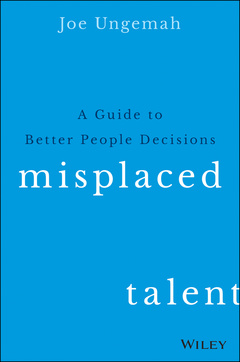Description
Misplaced Talent
A Guide to Making Better People Decisions
Author: Ungemah Joe
Language: English
Subject for Misplaced Talent:
Keywords
Misplaced Talent: A Guide to Making Better People Decisions; Joe Ungemah; Leadership Practice for the Corporate Executive Board; talent management; modern talent management; updated talent management; talent management approaches; talent management tools; talent management methods; talent management techniques; talent management value; effective HR practices; talent management handbook; talent development; professional development guide; relevant talent management; talent management best practices; effective talent management; updating HR practices; recruitment; recruiting; talent acquisition; learning and development; L&D; employee development; organizational development; organizational effectiveness; assessment; industrial organizational psychology; occupational psychology
224 p. · 15.8x23.1 cm · Hardback
Description
/li>Contents
/li>Biography
/li>
Misplaced Talent takes a hard look at the cluttered field of Talent Management, and offers a clear guide to making better people decisions in any organization. Deliberately challenging practitioners to do more, this insightful discussion sorts through the tools and techniques developed over the last century to examine their true relevance to the modern workplace. You'll learn which activities show the greatest potential to improve the lives of employees and the organizations they work for, and identify which of your existing practices don't really add enough value to be worth the expenditure of time, money, and potentially lost talent. The author asks you to make up your own mind about which approaches work best for your own specific talent decisions, but provides the best theory and practice available today as a foundation upon which to formulate a more relevant strategy.
In a world of big data, the potential to understand employees and react appropriately has never been greater. So why is Talent Management as an industry relying on outdated theory and practices? This book is a guide to bringing HR up to date, giving you the tools, techniques, and perspective you need to demonstrate more value to your organization.
- Adopt the tools and techniques most effective in today's workplace
- Identify and discard methods that don't add value to the organization
- Implement critical changes that can transform the HR function
- Make better people decisions based on psychology and research
Fundamentally, not much has changed in what constitutes good people practice. Practitioners must demonstrate the value of Talent Management, but the solutions implemented often fall short of the rigor and discipline they deserve. Misplaced Talent provides the insight you need to refocus attention and engage your organization about the value of better people decisions.
Foreword ix
Preface xiii
Chapter 1. Frameworks 1
Origins of Job Analysis 2
The Art and Science of Job Analysis 8
Behavioral Simplicity 13
The Tradeoffs 17
The Good and Bad of Frameworks 21
Chapter 2. Talent Acquisition 27
More Than a Single Brand 29
Let’s Be Realistic 35
Compelling Themes 40
From Message to Market 46
How It’s Done 50
Chapter 3. Capability Assessment 57
Evaluating Value and Risk 59
Legal Requirements 66
Assessment by Interview 68
Knowledge, Skills, and Abilities 77
Work Simulations 88
Where to from Here? 94
Chapter 4. Psychometric Assessment 97
But First, an Experiment 98
Employee Needs 101
Personality Traits 104
Shared Values 112
Motivated Employees Are Engaged Employees 115
Changes in Motivation with Age and Generations 118
Restoring the Balance with Person-Environment Fit 122
Chapter 5. Employee Development 127
Psychological Contract 129
Assessment for Development 133
Developmental Challenges 140
Support Through Coaching and Mentoring 146
Moving Together or Apart 151
Chapter 6. Change 155
Breaking the Psychological Contract 157
Succession Planning 159
High Potentials and the Learning Agile 163
Driving Performance 168
Big Data and Monitoring Change 173
From a Balanced to a Transactional Contract 175
Conclusion 177
About the Author 181
Acknowledgments 183
Resources 185
Index 195
JOE UNGEMAH helps his clients identify and implement critical transformations in the HR function and has led professional services groups for CEB in the US, Australia, and Ireland. Using his background as a registered psychologist, Joe translates the science behind selection and development decisions into easy to implement actions. He is also a skilled trainer, facilitator, and speaker.




